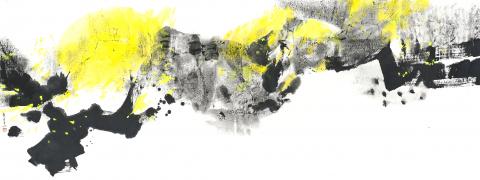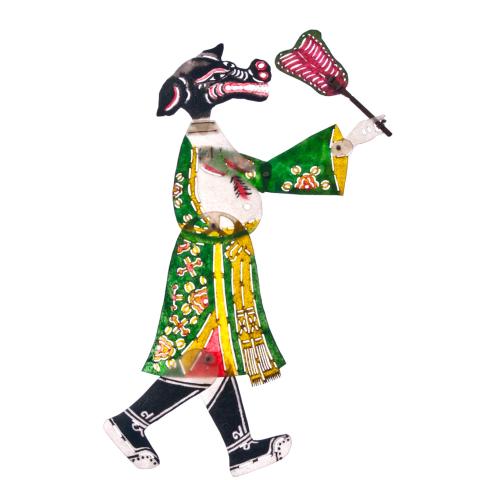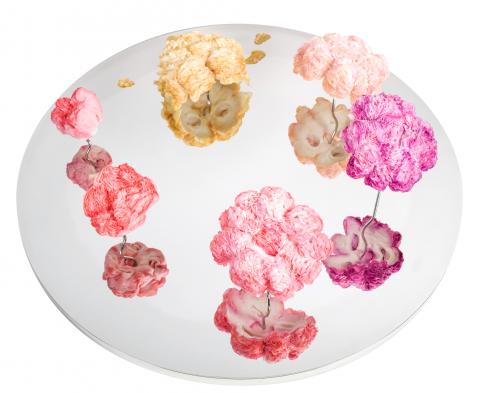The advancement of technology has made possible methods of communication that were unimaginable in the past, chipping away at boundaries such as time and space. With this in mind, the Digital Art Center in Taipei is currently showcasing Post Necromancy (後喚術), a collaborative exhibition featuring works that question the possibility of communicating with the dead via technology. Fascinating? Yes. Morbid? Absolutely. Crazy as it seems, the exhibition does a good job at fleshing out the idea of a person not being a “real person” in today’s world, as we are so consumed by our gadgets, letting these machines dictate how we live our lives, rather than making decisions ourselves.
■ Digital Art Center (台北數位藝術中心), 180, Fuhua Rd, Taipei City (台北市福華路180號), tel: (02) 7736-0708. Open Tuesdays to Sundays from 10am to 6pm
■ Until June 21

Photo courtesy of Liang Gallery
I’ve yet to come across an artist who manages to make childlike squiggles appear so poignant than Chinese artist Wang Huang-sheng (王璜生). Sent to the countryside with his calligrapher father during the Cultural Revolution, Wang had ample time to ponder and doodle. His signature style — ink squiggles on paper done with a single, unbroken line — is in part a critique on the elite, exclusive nature of literature, calligraphy and the like. Moreover, the squiggles point to the fact that there exists a world outside the realm of what words can capture. Wang’s paintings are currently on display at Taipei’s Lin & Lin Gallery. The exhibition is entitled Roaming | Apparition (游·象).
■ Lin & Lin Gallery (大未來林舍畫廊), 16, Dongfeng St, Taipei City (台北市東豐街16號), tel: (02) 2700-6866. Open Tuesdays to Sundays from 11am to 7pm
■ Opens tomorrow. Until July 5

Photo courtesy of Digital Art Center
Elegance of Landscape (山水風華) is a solo exhibition at Taipei’s Liang Gallery by Chinese-born Taiwanese artist Lee Chung-chung (李重重). Lee has been creating beautiful, bold abstract landscape paintings for decades. Born into a literary family from China’s Anhui province, her paintings are as deeply poetic. Images from Lee’s childhood in the Tainan countryside are translated into ink, expressed through baby blue skies, white sand mounds and topsy-turvy green pastures — all highly distinct from her father’s preference for traditional ink painting. While Lee’s father might have strived to conform, she wanted to stand out. According to Lee, bright colors such as pink and yellow are meant to create a loud statement, just like how “an elephant heavily puts down its foot.”
■ Liang Gallery (尊彩藝術中心), 366, Ruiguang Rd, Taipei City (台北市瑞光路366號), (02) 2797-1100, open Tuesdays to Sundays from 11am to 6pm
■ Until July 19

Photo courtesy of MOCA
Each time I return from visiting my family in South Korea, my suitcase is laden with top-of-the-range face masks and cosmetics — a symbol of both my unabashed vanity and the success of consumer society in convincing women that they “need” these products in order to be “attractive.” Chungli-born artist Hsu Wei-hui (徐薇蕙) has been challenging this idea of a constructed feminine beauty since her college days in Savannah, Georgia, to her residency in Seoul. She uses face masks — and cheek masks, neck masks and breast masks (who knew there was such a thing?) — as her prime medium, which she dyes with various shades of pink and twists into shapes that resemble flowers and firearms. The result, which is simultaneously beautiful and repulsive, enables viewers to envision the constant pressure that women are under to look and act a certain way. Her contorted face masks can be viewed at the Museum of Contemporary Art (MOCA) in Taipei in an appropriately-titled exhibition, Unknown Depths (未知的深處).
Female artists are really holding fort at MOCA this month. Another exhibition with a strong feminist flair is South Korean artist’s Yee Soo-kyung’s When I Become You: Yee Soo-kyung in Taipei (當我變成你:李受俓在台北). Yee is most well-known for her Translated Vase Series, a collection of sculptures made out of ceramic shards, twisted and reshaped to resemble curves on the female body while also protesting the archaic idea of “no pain, no gain.” For this particular exhibition, Yee created female alien-like sculptures inspired by religious figures. While visibly different than her ceramic shard sculptures, similar themes, such as traversing the separate worlds of tradition and modernity, and consciousness and subconsciousness, are explored through these figurines as well.
■ Museum of Contemporary Art, Taipei (台北當代藝術館), 39, Changan W Rd, Taipei City (台北市長安西路39號), tel: (02) 2552-3720. Open Tuesdays to Sundays from 10am to 6pm
■ Unknown Depths opens tomorrow and is until July 19. When I Become You is until Aug. 2
The National Palace Museum in Taipei has been rather fashion-forward this past year, showing one exhibition after another revolving around different fashion trends throughout Chinese history. Their latest exhibition, The Splendor of Ethnic Costumes and Accessories from Guizhou (銀燦黔彩─貴州少數民族服飾), is not to be missed for those immersed in the world of fashion or the study of ethnic minorities. Guizhou province in southwest China, known for its spectacular mountain scenery and ancient villages, is also home to some ethnic minority groups like the Miao and the Dong. Settling in the area hundreds of years ago, these various ethnic groups have long produced vibrant folk art incorporating elements from various cultures. This is exemplified in many aspects of life in the villages, most notably in weaving and embroidery, as well as in jewelry-making. Some of the gorgeous costumes and accessories are currently on display as part of the museum’s exhibition.
■ National Palace Museum (國立故宮博物院), 221, Zhishan Rd Sec 2, Taipei City (台北市至善路二段221號), tel: (02) 2881-2021. Open daily from 9am to 5pm
■ Until Sept. 1

May 18 to May 24 Pastor Yang Hsu’s (楊煦) congregation was shocked upon seeing the land he chose to build his orphanage. It was surrounded by mountains on three sides, and the only way to access it was to cross a river by foot. The soil was poor due to runoff, and large rocks strewn across the plot prevented much from growing. In addition, there was no running water or electricity. But it was all Yang could afford. He and his Indigenous Atayal wife Lin Feng-ying (林鳳英) had already been caring for 24 orphans in their home, and they were in

President William Lai (賴清德) yesterday delivered an address marking the first anniversary of his presidency. In the speech, Lai affirmed Taiwan’s global role in technology, trade and security. He announced economic and national security initiatives, and emphasized democratic values and cross-party cooperation. The following is the full text of his speech: Yesterday, outside of Beida Elementary School in New Taipei City’s Sanxia District (三峽), there was a major traffic accident that, sadly, claimed several lives and resulted in multiple injuries. The Executive Yuan immediately formed a task force, and last night I personally visited the victims in hospital. Central government agencies and the

Australia’s ABC last week published a piece on the recall campaign. The article emphasized the divisions in Taiwanese society and blamed the recall for worsening them. It quotes a supporter of the Taiwan People’s Party (TPP) as saying “I’m 43 years old, born and raised here, and I’ve never seen the country this divided in my entire life.” Apparently, as an adult, she slept through the post-election violence in 2000 and 2004 by the Chinese Nationalist Party (KMT), the veiled coup threats by the military when Chen Shui-bian (陳水扁) became president, the 2006 Red Shirt protests against him ginned up by

As with most of northern Thailand’s Chinese Nationalist Party (KMT) settlements, the village of Arunothai was only given a Thai name once the Thai government began in the 1970s to assert control over the border region and initiate a decades-long process of political integration. The village’s original name, bestowed by its Yunnanese founders when they first settled the valley in the late 1960s, was a Chinese name, Dagudi (大谷地), which literally translates as “a place for threshing rice.” At that time, these village founders did not know how permanent their settlement would be. Most of Arunothai’s first generation were soldiers